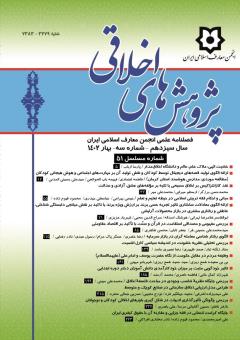بررسی جایگاه نظریۀ تناسب وجودی در مباحث فلسفۀ اخلاق
محورهای موضوعی : اخلاق و تربیت اسلامی
1 - پژوهشگاه علوم و فرهنگ اسلامی، قم، ایران.
کلید واژه: نظریۀ تناسب وجودی, نظریۀ ارزش, اخلاق هنجاری, فرا اخلاق,
چکیده مقاله :
نظریۀ تناسب وجودی نظریهای است دربارۀ ارزش اخلاقی که بر مبنای نگاه واقعگرایانه به اخلاق ارائه شده است. این نظریه بر آن است که همۀ ارزشهای اخلاقی قابل ارجاع به یک ارزش بنیادین هستند؛ آن ارزش بنیادین تناسب وجودی است و تناسب وجودی با خدا در این نظریه نقش محوری در ارزشبخشی اخلاقی دارد. یک سؤال دربارۀ این نظریه ناظر به جایگاه این نظریه در فلسفۀ اخلاق است. آیا این نظریه یک نظریۀ فرااخلاقی است یا به قلمروی اخلاق هنجاری تعلق دارد یا حالت سومی قابل فرض است؟ با بررسیهایی که در این تحقیق صورت گرفت این نتیجهگیری به عمل آمد که هدف اساسی نظریۀ تناسب وجودی یک هدف نظری در قلمروی اخلاق هنجاری است و برخی اهداف عملی هنجاری نیز از طریق آن قابل تحقق است. با اینحال، مباحث و مدعیاتی که در این نظریه مطرح میشود محدود به اخلاق هنجاری نیست؛ بلکه گاهی جنبۀ فرااخلاقی پیدا میکنند و چه بسا از آن هم فراتر روند و حوزههایی دیگر از فلسفه را دربرگیرد. بنابر این، بهتر است این نظریه را یک نظریۀ ارزش مطابق با اصطلاحی رایج بدانیم که همۀ این حوزهها را پوشش میدهد.
Theory of harmony in existence is a theory of moral value based on a realistic view of morality. This theory holds that all moral values return to a fundamental value; That fundamental value is harmony in existence, and harmony in existence with God plays a central role in moral value in this theory. One question about this theory concerns the place of this theory in the ethics. Is this theory a metaethical theory, or does it belong to normative ethics, or is a third state presumable? By the studies that were done in this research, it was concluded that the basic aim of the theory of harmony in existence is a theoretical aim in the field of normative ethics and also some normative practical aims can be achieved through it. However, the arguments and claims made in this theory are not limited to normative ethics; Rather, they sometimes take on a metaethical aspect, and may go beyond that to include other areas of philosophy. Therefore, it is better to consider this theory as a value theory in accordance with a common term that covers all these areas.
نهج البلاغه
مبینی، م. ع. (1390). تأملاتی معناشناختی در حقیقت ارزش اخلاقی. نقد و نظر، 16(64)، 2-26.
مبینی، م. ع. (1392). تناسب و سازگاری وجودی به منزلۀ ارزش بنیادین. نقد و نظر، 18(69)، 2-33.
مبینی، م. ع. (1399). خدا، ارزش، عقلانیت: گامی بهسوی نظریۀ «تناسب وجودی» در باب ارزش. قم: پژوهشگاه علوم و فرهنگ اسلامی.
Adams, R. M. (1973). A Modified Divine Command Theory of Ethical Wrongness. In T. L. Carson & P. K. Moser (Eds.), Morality and the Good Life: Oup Usa.
Adams, R. M. (1979). Divine Command Metaethics Modified Again. Journal of Religious Ethics, 7(1), 66 - 79.
Copp, D. (2005). Introduction: Metaethics and Normative Ethics. In D. Copp (Ed.), The Oxford Handbook of Ethical Theory (Vol. 1, pp. 3-35): Oxford University Press.
Hirose, I., & Olson, J. (2015). The Oxford Handbook of Value Theory: Oxford University Press USA.
McPherson, T., & Plunkett, D. (2017). The Nature and Explanatory Ambitions of Metaethics. In T. McPherson & D. Plunkett (Eds.), The Routledge Handbook of Metaethics (pp. 1-28): Routledge.
Schroeder, M. (2017). Normative Ethics and Metaethics. In T. McPherson & D. Plunkett (Eds.), The Routledge Handbook of Metaethics (pp. 674-686): Routledge.
Schroeder, M. (2021). Value theory. In E. N. Zalta (Ed.), The Stanford Encyclopedia of Philosophy (Fall 2021 ed.): URL =
Smith, M. (1994). The Moral Problem. Oxford: Wiley-Blackwell.
Timmons, M. (2013). Moral Theory: An Introduction (2nd ed.): Rowman & Littlefield Publishers.
Zimmerman, M. J. (2015). Value and Normativity. In I. Hirose & J. Olson (Eds.), The Oxford Handbook of Value Theory (pp. 13-28). New York: Oxford University Press.


